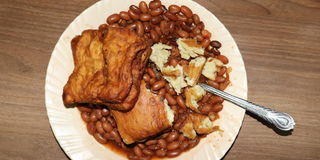Why Nakuru residents are ditching chapo madondo for mandazi madondo

A plate of mandazi and beans served at a Kibandaski in Kaptembwa estate.
Kibanadaskis have always been known to promote a creative food culture that helps their customers fill up their stomachs at a cheaper cost than other food eateries.
We have the smocha- chapati and smokie, another is the mayai pizza where you fry eggs with French fries.
MtaaWangu recently discovered another way where you take your chapati and sandwich a fried egg and avocado inside it.
However, the combination of beans and mandazi (mandazi madondo) has also gained prominence as an affordable option compared to beans’ previous pairings of chapati and rice whose prices continue to soar.
Beans have for a long time been a great accompaniment because of their taste and high protein content.
But the interesting bit is how mandazi, a breakfast snack, has replaced other carbohydrates (chapati and rice) as a lunchtime go-to.
This combo has become a staple food for the residents of Kaptembwo in Nakuru west.
We meet John Kokinyo, a resident of Kaptembwo, dashingly dressed, as though prepared to go somewhere important.

John Kokinyo a resident of Kaptembwa eating in a kibanda.
But first, he enters one of the kibandaskis in the area and orders an interesting combo of beans and mandazi (mandazi dondo).
The famous chapo dondo may have been faced out due to competing prices as mandazi dondo goes for Sh.30 as opposed to chapo dondo which in some areas has hit the Sh.50-70 mark.
Kokinyo notes that the mandazi dondo option is a cheaper selection for him as chapati dondo has seen a price increase, which helped him reduce his expenses of eating out.
Racheal Kerubo, a waitress at this kibanda is excited as she narrates to us this new dish and the demographic that consumes it.

Racheal Kerubo, a waitress at a food kiosk in Nakuru city.
“We started serving beans with mandazi when the price of chapos increased. The breakfast snack gradually changed into a constant serving, regardless of the time of day, .
Kerubo says the dish is most popular among men who work in construction as well as others in white collar jobs. The women are yet to come around.
“It has also remains to be the most affordable combination over time even as prices of other foods have kept increasing,” she notes.
